Trying to understand everything about LPG is one of the things that concerns people most when they’re new to motorhoming and caravanning. But even people with tonnes of experience know that gas use, accessibility, management and maintenance, are very different when taking your van into deep winter conditions for a ski holiday.
Motorhome skiers and caravanners alike are heavily dependent on maintaining good supplies of gas to keep them going whilst on the road in the winter. For caravanners there are a number of critical issues, which they need to consider – making gas choices more complicated than for people in motorhomes and campervans.
In this article we will cover what you need to know to choose the right gas solution for you and your van.
- What is Gas/LPG/Autogas/GPL?
- LPG and Low Temperatures
- What are My Gas Choices?
- How Much Gas Will I Need?
- The Importance of The Weight You Carry
- Regulators
- Exchangeable Cylinders
- Adaptors
- Refillable Cylinders and Tanks
- Piped Gas
- Travelling with LPG
- Gas Summed Up
Whilst there are similarities between motorhome and caravan gas installations, motorhome users will find some important differences which are detailed where important.
Disclaimer: All articles posted on Winterised.com are designed to provide information and advice on how to identify what you might need when you take your caravan or motorhome skiing in Europe. They are not intended to be definitive reviews, but a guide to help you with further research to choose what is right for you. As with all projects that are potentially dangerous, working with LPG installations requires great care. If you are not completely confident about working with gas you should contact a gas safe or NCC approved technician to do the work for you – THIS IS NOT ONE FOR THE ENTHUSIASTIC DIYER
What is Gas/LPG/Autogas/GPL?
This is all the same thing but you’ll see it referred to in each of these ways throughout this article and in real life depending on context and where you are.
Let’s talk propane.
Gas comes in pressurised bottles and is used in heating and cooking in most motorhomes and caravans. We even use a small bottled camping gas canister to power our Jet Boil when we’re on the road which makes for a far faster brew and doesn’t require connecting your gas supply mid-journey.
For many three-season caravanners and motorhomers in the UK, the gas of choice will be blue bottle butane Calor Gas. Whilst other bottled gas brands are available in the UK, Calor is often regarded as the most accessible for cylinder exchange purposes – think of it as the Hoover of vacuum cleaners.
Butane and Propane: What Normal People Call it
Propane bottles do actually contain butane, and for keyboard warriors, getting into the semantics and science of this topic is a favourite pastime. This serves no real value to you the reader looking for help and advice, so for the purposes of this article, butane is blue bottle, propane is red bottle. Simple. If you want to understand the chemical composition of LPG and it’s various mixes and uses, Google will present you with a plethora of extremely dull articles!
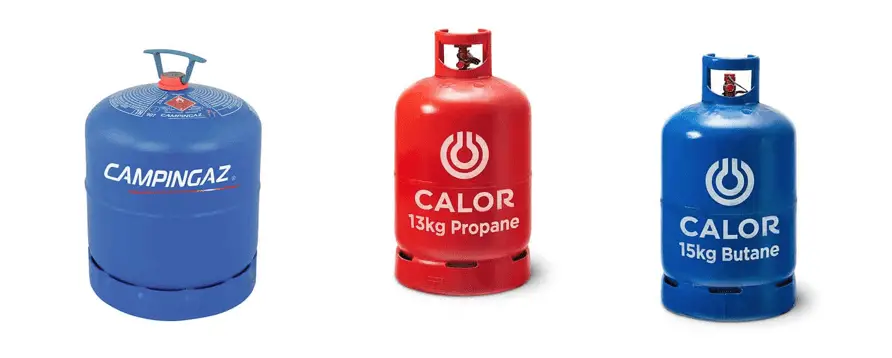
LPG is Affected By Temperature
If you’re new to motorhome or caravan skiing, there is one critical piece of information you must furnish yourself with:
EVERYTHING IN YOUR VAN IS AFFECTED BY TEMPERATURE
Gas is no different.
Once temperatures fall below freezing, butane (blue bottle) is unserviceable, unable to vaporise efficiently and so a move to red bottle Calor propane gas is essential.
Propane is great for winter use as it is useable at temperatures down to around -40OC depending on the mix, which is designed to enable it to remain as a gas below the -2OC tipping point of butane.
LPG companies determine what the mixture of propane to butane will be and the additives put in the cylinder or available at the pump, and as winter sets in, the balance will tip towards a mixture that will resist the colder temperatures. In Europe this is the same as in the UK, with gas companies increasing the propane mix to higher levels earlier in the season to reflect the colder conditions. In some high altitude fuel stations, a ‘summer’ mix is never available at the pump.
What are My Choices for Gas Supply?
You cannot exchange or refill Calor Gas cylinders outside of the UK, so sourcing an alternative solution is necessary.
Depending on how you run your ‘chalet on wheels’ and how warm you like to be, it’s likely you will need in excess of 2kgs of gas per day.
Even if you are being careful with electricity use and staying on European campsites, for a caravan skier a 6kg Calor cylinder is only really enough to get you on site and set up unless you’re hot-footing through the night to reach your destination. Most motorhomes benefit from the fact that the habitation area of the vehicle is heated to an extent whilst travelling, whereas caravaners are starting from ambient temperatures each time they set up.
Those with diesel heaters have an alternative heat source so this article is focused on those largely dependent on gas for heating through choice or necessity.
Your Options for Gas are:
- Take it With You – Taking sufficient Calor Gas with you for the trip (including transit days)
- Get exchangeable cylinders sourced in the country where you are skiing
- Buy refillable cylinders sourced in the UK
- Piped gas – supplied by some sites in Austria, Italy & France
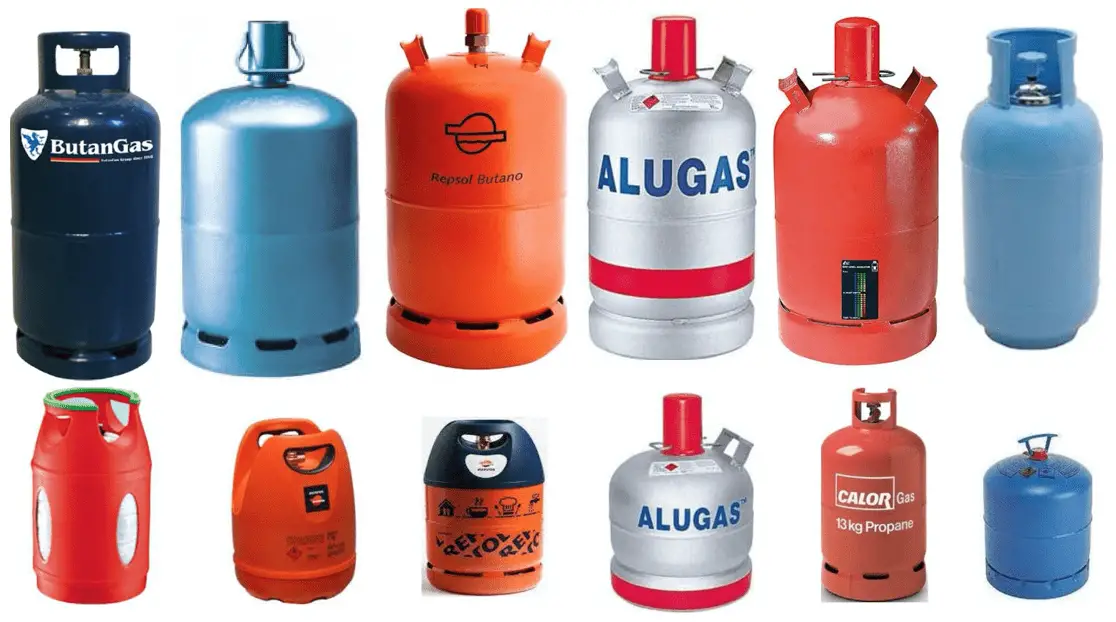
How Much Gas Will I Need?
How much gas you will need will very much depend on how warm you like your van; how effective your insulation is; how much cooking you do; if you use an on-board shower; and how cold external temperatures are.
With electricity often charged at €0.80 per amp hour on European campsites in winter, it can be very expensive to run your heating on electric (most likely to be Truma or Adle but Whale and other manufacturers are commonly fitted). Where you are metered or restricted in your electricity use, gas will always prove more cost effective and often significantly more efficient if you have a blown air system.
These examples may help you to determine your own usage:
John’s Caravan
- 8m x 2.3m caravan has a 6.35m internal body-shell
- Alde heating
- Running heating 24/7 with the thermostat set on 7OC overnight and while out during the day, and then between 15OC and 18OC during the evening
- Cooking most meals in the van
Average Usage: 11kg cylinder every 6 days (approx. 1.8kg/day)
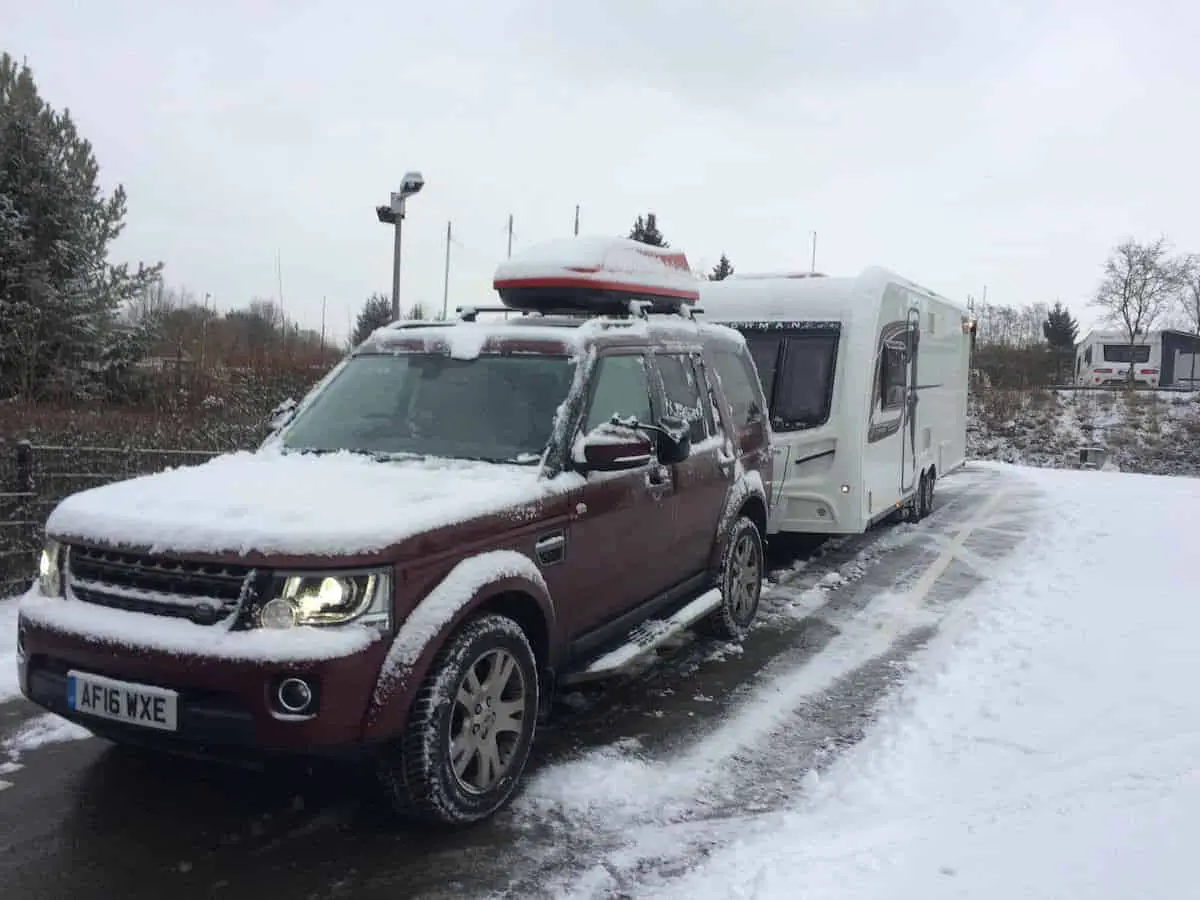
Hannah and James’ Coachbuilt Motorhome
- 7.21m x 2.3m including cab
- Whale air blown heating
- No heating run whilst not in the van during the day
- 18OC whilst in the van in evenings
- 7OC overnight
- Most meals cooked in the van and lots of coffee brewed
- One shower each per day when water isn’t frozen!
Average Usage: 2kg/ day off grid
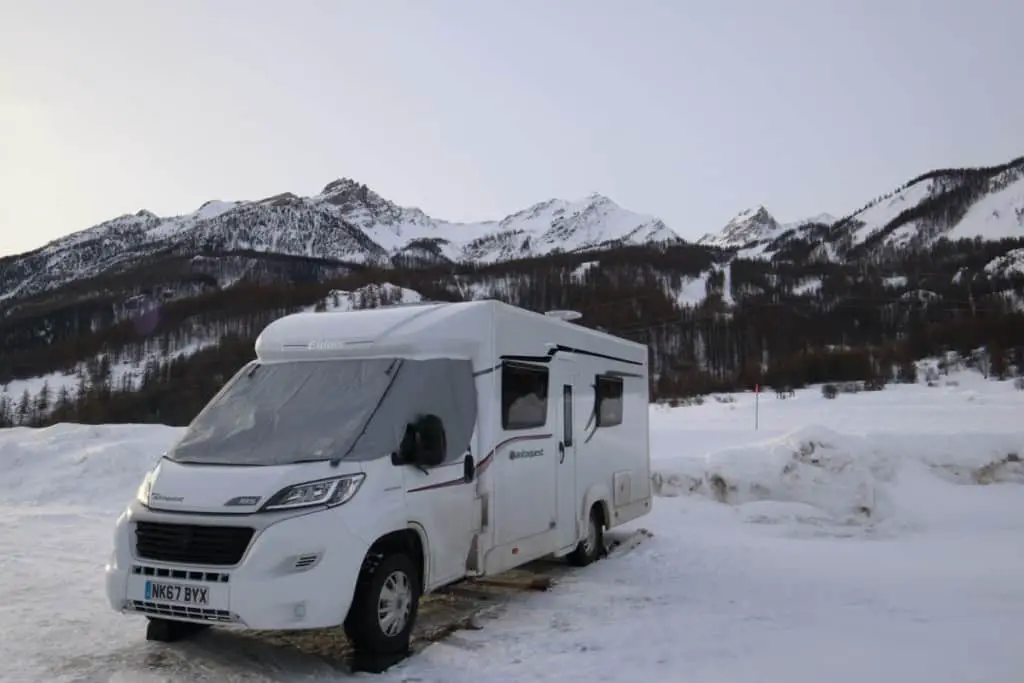
You may like your van much warmer, so you will use a lot more gas. John’s German neighbour in Italy last winter liked the temperature in his van set at around 20OC most of the time and was using an 11kg cylinder every 3 days.
Weight Matters
Caravanners are usually far more conscious of their weight than motorhomers, but there are important factors for both to consider.
Caravanners are usually aware of three key weights for their caravan:
- MIRO (mass in running order or unladen weight)
- MTPLM (maximum technically permitted laden weight or gross vehicle weight)
- Noseweight (the maximum weight that can be applied through the hitch to the tow bar)
Since 2010, the MIRO has included the weight of a small gas cylinder, but not the battery (!). This is to enable UK manufacturers to achieve European Type Approval and to enable transparency across the EU when buyers are choosing caravan. However, this has caused weight allowances for personal items (MTPLM-MIRO) to reduce as manufacturers compete to raise specifications without raising the weight of the caravan.
The consequence is that an additional or larger cylinder will eat into your user payload and have an impact on the Noseweight of your caravan. It is also worth noting that the maximum weight allowed for your towbar may be less than the maximum Noseweight for your caravan.
This isn’t quite as complicated for motorhomes, but whether your gas is considered part of your payload, or included in your allocation is determined by a number of factors that are far more complicated than is necessary (standard vehicle bureaucracy) – so the advice is to check the specification of your motorhome or van and it’s payload allowances to determine just what you can legally and safely carry.
Cylinder Weight
Most exchangeable gas cylinders are made of steel or aluminium and have stamped on the neck the ‘tare’ or empty weight. This will vary, as all cylinders have slightly different weights. In the UK, Calor cylinders have a metal collar with the empty weight stamped on it in pounds and ounces with the contents being sold in kilograms (yup – you couldn’t make it up).
To Work It Out Properly
To calculate the weight of a full cylinder you convert the imperial measurement to kilos and add the gas weight in the bottle. In the EU all weights are in kilos. In the picture below the Calor 6kg cylinder weighs 14kg full, the German/Austrian 11kg cylinder weighs 23.2 kg and the Italian 10kg cylinder 21.8kg.
To be sure that you do not run out of gas whilst on site it is recommended to have 2 cylinders in your gas locker to enable a quick changeover, so if you’re in a caravan and you choose to carry two German cylinders whilst towing, you are adding 46.4kgs to your Noseweight and eating into your user payload by 32.4kg.



Avoiding the Maths – The Winterised Way (John’s way is better)
In general, caravanners pay far more attention to weight than motorhomers – especially those who travel in deep winter conditions. Load distribution and the implications of having a sub-optimal weight set up, or worse still, getting it wrong entirely have a more immediate feedback loop for caravaners.
That doesn’t however mean that you should simply lob everything in and forget about it if you’re in a motorhome or van – far from it. Whilst you don’t need to forensically organise where you stow your kit, you should go for an even distribution of weight, consider where your drive wheels are, and if you are designing your own van, make certain you know how your layout will affect what you can carry and where. From batteries to water tanks – it all has a significant role to play in the stability and safety of your van.
The most important thing to focus on is ensuring that without any doubt, that you are not, or will ever be, travelling overweight. The consequences are extremely high legally (especially in Europe) – universally (and perhaps surprisingly) one of the most serious traffic violations – but more importantly, the risk to life and limb and motorhome is grossly underestimated.
Here’s how we do it:
- Load the van
- Take everything out that doesn’t serve at least 2 purposes (e.g. dog = PT instructor and hot water bottle)
- Fill up with water and fuel
- Go to a VOSA weigh station (or a scrap yard) and get weighed – it is not worth relying on your guess-timations
If we discover that the weight is marginal, I vow to have a diet of dust until departure and James removes all the crockery. We never dispense with boards or skis or salad cream.
Regulators
Most snomads know that gas only runs out when it is dark, it’s snowing outside and you carelessly chucked your big socks somewhere in the van that is now a complete mystery.
Changing a cylinder in the freezing cold is not funny, so it is definitely worth upgrading your bulkhead regulator from single port to twin port which will allow you to change cylinders with the flick of a switch, rather than removing and changing gas hoses – head stuck in a tiny cubby or hands fishing in your gas locker whilst you try and complete an “I’m A Celebrity’ style challenge for your stars (flowing gas) so you can take meals back to camp.
If you’re on a generous budget, auto switchover regulators can be fitted which are great but do risk leaving you with two empty cylinders if you forget to check regularly how much gas you have left. Gas supply gauges are also available including electronic versions, which have a meter inside the van and vary in tech appeal.
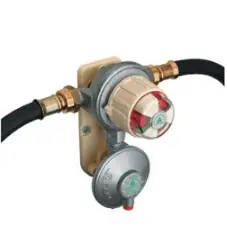
Exchangeable Cylinders: Occasional Trip Option
For those choosing campsites, a way of getting around the weight issue is to rent cylinders from your hosts. Many European campsites will sell you a cylinder and exchange it as required whilst you are there and then buy it back when you leave.
Example: In Northern Italy at Camping Pemont in Livigno in 2020 a 10kg cylinder is €48 with a €15 refund on departure (correct at time of writing).
If this might work for you, it is worth an email to your chosen campsite to ask if the service is available. You will need adapters to connect to your regulator so keep reading.
If you are able to manage the extra weight of larger cylinders it is worth considering buying your own in your destination country.
Germany and Austria share a standardised exchange system where cylinders are sold outright initially (not on deposit as Calor do in UK) and are widely available in supermarkets, filling stations and campsites. Prices vary with the highest prices on campsites. There is also a large tax difference between Austria and Germany making buying cylinders much cheaper in Germany.
John’s Example:
A couple of years ago I bought a full 11kg cylinder outright in a supermarket near the German/Austrian border for €55, the same cylinder at the campsite at Pettneu near St Anton was €105 (€50 difference!). In January 2020 an 11kg refill exchange at the same supermarket in Germany was €17.50. In Austria on our campsite a week later, it was €35 (50% more).
Winterised Tips For Exchangeable Cylinders:
- It is possible to buy exchangeable cylinders in this way in Italy and France from a variety of outlets
- Before you buy, check if the cylinder will fit in your gas locker and it is the right circumference to be securely attached to the restraining harness
- If an 11kg cylinder is too big or too heavy for your caravan or motorhome, then in Germany and Austria 6kg versions are available, and in France 9kg
Adaptors
It is easy to get confused when sourcing the adaptors you will need to connect your bulkhead regulator to a cylinder sourced in Europe.
Many online suppliers sell adaptors and advertise them as suitable for use in Europe, but they are in fact for connecting fixed fill points on motorhomes and LPG cars to Autogas pumps in filling stations and not for connecting your regulator to a cylinder.
In the UK most propane connectors will be a hose with a regulator connector on one end and a bullet type connector for the cylinder head on the other as below:
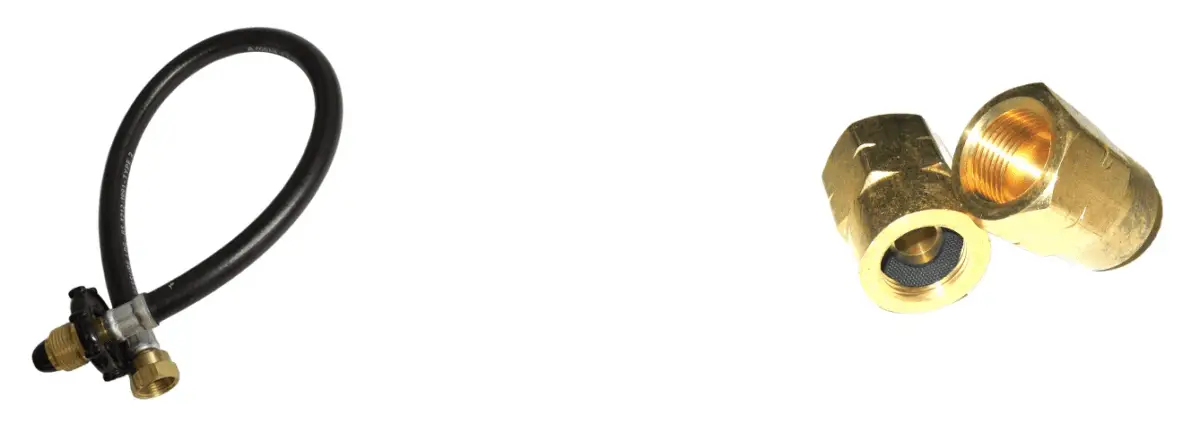
By using the adapter above it is possible to connect your existing hose onto French cylinders. These are available from online suppliers such as Socal in Southampton.
For about £45 you can make up a kit for connecting to most European cylinders. You will need:
- a length of hose with a W20 connector on one end for your regulator
- a 21.8LH on the other to connect to an adapter for the cylinder
- Many kits on the market are based on an adapter for German cylinders so you will need one of these as well

There are numerous online suppliers for these parts examples of which are:
Refillable Cylinders and Tanks: Long Term Option
With LPG prices in the UK averaging around 67p per litre and in Europe as low as 45p per litre, it is not hard to see why refillable gas cylinders have become so popular especially with the motorhome community.
A kg of LPG equates to about 1.96 litres so a 6Kg cylinder would cost around £7.88 in the UK to refill and potentially as low as £5.30 in Europe. With a 6kg Calor exchange costing around £23 the savings are obvious, but there are a number of considerations before changing to refillable.
The three current manufacturers easily available in the UK, Gaslow, Gasit, and Safefill have a range of cylinder sizes to enable choice with regard to weight and capacity. Gaslow and Gasit supply steel cylinders which are similar to exchangeable types, but Safefill supply cylinders made of a high density polyethylene which is translucent. This means that you can see how much gas is in the cylinder and they weigh about half as much as a steel cylinder. An important point for caravanners and for anyone who finds lugging the tradidional steel cylinder around a challenge.
Changing to refillable requires a financial outlay (see chart below). Buying cylinders, hoses and filling adapters can cost several hundred pounds and take years of gas consumption to realise the financial benefits but the other benefits are particularly attractive for those of you in motorhomes and vans opting to stay off-grid or in aires.
- They are portable if you change your caravan or motorhome
- They have a lifespan of upto 10 years (possibly longer with manufacturer re-certification)
- If you opt for Safefill bottles, they are significantly lighter than any alternative
- With a simple set of adaptors you can fill them in all over the world (note points below)
- Your cash is recouped very swiftly in heavy winter use
It is however worth getting the calculator out before reaching for your credit card. There are a number of optional extras available with some cylinders such as bluetooth capacity indicators and you may need to change hoses to use them.
We (Hannah and James) simply plugged our Safefill cylinders into the existing regulator that was factory fitted to the van and we were good to go.
The Legal Side of Refillables
There is a continuous debate as to the legality and advisability of refilling loose cylinders on petrol station forecourts.
It is illegal to attempt to fill a traditional exchangeable cylinder in the UK and EU
Why?
Any LPG cylinder should only be filled to 80% of its physical capacity to allow for the safe expansion of its contents. Purpose made refillable cylinders are fitted with a device to prevent overfill, exchangeable cylinders are not.
However, not all petrol station operators both in the UK and in mainland Europe feel that an untrained person should fill an LPG cylinder at all, and do not allow it on their forecourts. The reason being that is not always possible for a forecourt attendant to know or recognise the difference between a cylinder with the safety valve fitted (as the refillables available in the UK have) and a standard exchangeable gas bottle. Therefor far easier to ban it altogether.
This is supported by the European Liquified Petroleum Gas Association (AEGPL) who state: “The filling of pressure receptacles may only be carried out by specially equipped centres, with qualified staff using appropriate procedures”
This is endorsed by the EU Commission Inland Transport Committee. All three of the UK ‘Refillables’ suppliers have put a lot of energy into agreeing and identifying UK sites where you can legally and safely refill their cylinders and anecdotally there are hundreds of sites in the EU where it is permitted. The difficulty remains that you cannot be sure that when you turn up at an LPG station in the UK or in Europe that you will be allowed to refill your loose cylinder, and you may be fined for attempting to do so in some countries. More likely, someone will run out of the service station shouting and waving you off or yell at you over the forecourt tanoy!
It is becoming increasingly challenging to fill up these bottles in fuel stations in the UK and that has put some people off the investment – however, for the deep winter tourer, it is still an investment worthy of consideration, especially if you principally ski in France where LPG is widely available and accessible to people with refillable gas bottles.
External Fill Points and Tanks
It is perfectly acceptable and legal throughout the UK and most of Europe to use an Autogas (LPG) pump to refill a fixed LPG installation through a dedicated fill point in the vehicles bodywork. These can be fitted to caravans in the gas locker but are likely to make a significant impact on Noseweight and user payload but there are other issues caravanners face with this kind of set up.
It is fairly straightforward to have a fixed fill point fitted to the side of your gas locker and connected to a refillable system, whether that’s to bottles housed internally or a tank which might even be underslung. Gaslow and Gasit have a dealer network that will undertake this work on motorhomes, vans and caravans but if you know what you are doing (and we mean in a gas sense – not a self-build van sense), it is perfectly possible to fit your own external fill point to your caravan, campervan or motorhome.
The problem for caravanners is that you can only then refill your cylinders if you take your caravan to the filling station which is impractical if you are pitched on site with awning set up. Maneuvering a car and caravan in a filling station to access an Autogas pump can be equally as challenging as filling up with fuel.
Finally to compound the issue, LPG facilities are not always conveniently located near your chosen ski resort and so forward planning on this front is always advised.
Filling Up LPG from the Pump – Finding Places To Fill up with LPG
There are a number of good online resources to find Autogas stations including the popular mylpg.eu app. https://www.mylpg.eu/ and our very own Snomadsites website https://snomadsites.com/
It’s strongly advised to have a ‘Plan-B’ when using any app – and myLPG has been known to catch people out with service stations not being open or the LPG pumps being closed. We try really hard to verify the LPG stations featured on snomadsites.com as frequently as possible.
It is important to note that we do not believe you can graduate to an ‘intermediate snomad’ until you have completely run out of gas at least 6 hours, and one treacherous mountain pass away from an operational LPG pump without an overcautious attendant on site.
Sundays and Holidays
LPG pumps have to be manually authorised and therefore, a Pay at Pump, splash and dash is not possible. This means that if you rock up on a Sunday, after hours or a public holiday across much of Europe, you will not be able to fill up.
Adaptors
You will also need yet another set of adaptors to allow you to access LPG pumps in the Europe. This article from the Gaslow shop is very helpful, with kits being available from many suppliers including Outdoor Bits.
Even though there is much to think about with changing to a refillable system, it is clearly increasingly popular with UK caravanners, many of who are claiming to be using them successfully throughout Europe – they have been a very popular solution for motorhomers for some time and despite the challenges in filling in some places, they still present the best gas solution to many motorhome skiers.
Gaslow vs Gasit vs Safefill
Here’s a table that details the main differences between the three major brands of refillable cylinders available in the UK.
| Supplier | Cylinder Material | Empty Wt (kgs) | Capacity at 80% | Full Wt (kgs) | Height (mm) | Diameter (mm) | Circumference (mm) | Cost | Warranty | Replace Hose |
| Gaslow 2.7kg | Steel | 5.2 | 4.56 litre | 7.53 | 310 | 202 | 635 | £140 | 10 years | Yes |
| Gaslow 6kg | Steel | 8.3 | 11.6 litre | 14.22 | 460 | 246 | 773 | £159 | 10 years | Yes |
| Gaslow 11kg | Steel | 12.4 | 21.0 litre | 23.11 | 530 | 302 | 949 | £179 | 10 years | Yes |
| Gasit 6kg | Steel | 7.0 | 11.5 litre | 12.86 | 470 | 246 | 773 | £147 | 2 years | Yes |
| Gasit 11kg | Steel | 10.7 | 21.5litre | 21.57 | 550 | 304 | 955 | £164 | 2 years | Yes |
| Safefill 5kg | Polyethylene | 3.4 | 8.5 litre | 7.73 | 396 | 310 | 974 | £153 | 10 years | No |
| Safefill 7.5kg | Polyethylene | 4.1 | 14.5 litre | 11.5 | 482 | 310 | 974 | £158 | 10 years | No |
| Safefill 10kg | Polyethylene | 5.0 | 19.5 litre | 14.95 | 583 | 310 | 974 | £163 | 10 years | No |
Piped Gas
A number of campsites, esspecially those in Austria and Italy that have facilities for seasonal pitches, offer LPG piped direct to your pitch. Usually the campsite provides the connector hose which connects directly to your regulator or BBQ point and a one off connection charge is applied.
Consumption is metered and charged either by cubic metre or litre. Costs are normally cheaper than bottled gas, but more expensive than LPG from a fuel station.
This is a very convenient option for caravanners, motorhomers and particularly seasonnaires and worth looking out for as you make decisions on which sites you wish to visit. Always contact the site first to see how they operate the facility and if it would be available for you on your prefered dates.
Travelling with LPG
It’s pretty important that you know what you can and can’t do in terms of travelling with LPG. It’s not as straight forward as you would imagine – vehicles are allowed to be field by LPG so why would there be any restrictions on carrying gas cylinders? Well – there are so make sure you are aware of them as things like this are only going to get tighter in terms of regulation and enforcement.
The following information comes directly from the service providers so if you are unsure, please do contact them prior to travel.
Travelling with LPG on Ferries
Propane and butane gas for private use only (i.e. camping purposes). Maximum of 3 cylinders, the combined weight of which must not exceed 47KGs for lighting, cooking or heating purposes only, may be offered to the ship without documentation or in accordance with IMDG regulations.
Travelling with LPG cylinders by EuroTunnel
If travelling with a campervan, caravan or any other vehicle fitted with cooking facilities, any flammable gas container must be declared when asked and will be checked at the appropriate checkpoint by Eurotunnel Le Shuttle
Flammable gas containers may be transported with the following restrictions:
- For portable containers (cylinders/bottles, etc): Maximum of 47kg per cylinder and no more than 50kg per Vehicle if more than 1 container;
- For fixed containers (tanks): Maximum of 47kg per container and no more than 50kg per Vehicle if more than 1 container.
- Fixed containers must be no more than 80% full. The capacity of the container will be checked by Eurotunnel staff.
In all cases, transport of gas containers to power domestic services (e.g. cooking, lighting & heating, etc.) are restricted as outlined below:
Portable Gas Containers: For the purposes of this text, this means cylinders/bottles containing flammable gas that can be moved from the vehicle for replacement or re-filling. The quantity of gas is limited to 47kg (or approximately 93 litres) maximum for a single container and to 50kg (or approximately 99 litres) maximum in the case of several containers.
Fixed Gas Containers: For the purposes of this text, this means fixed containers that are permanently installed or fixed in a vehicle and are refillable from outside the vehicle.
The quantity of gas is limited to 47kg (or approximately 93 litres) maximum for a single container and to 50kg (or approximately 99 litres) maximum in the case of several containers. Each container must be no more than 80% full.
The quantity will be checked via the gauge or remote indicator but if neither are present, the vehicle will be refused.
Combination of portable and fixed containers: If your vehicle is fitted with a combination of portable and fixed containers, the quantity of gas is limited to 50kg (or approximately 99 litres) maximum and the rules previously described apply.
Note: All containers and/or gauges/indicators must be of easy access by our staff for any check. Gas containers must be switched off whilst travelling and connection systems must be in good condition. Opening the container tap or using domestic services as described above is strictly forbidden until the vehicle has unloaded at the arrival Terminal
Tunnels and Trains
There are some awesome tunnels and vehicle trains that you can travel on as a snomad and they all have their own regulations and restrictions regarding gas transportation and LPG fuelled vehicles. The responsible thing to do is check in advance or at the very least, declare that you are carrying LPG cylinders. Most tunnel operators will simply check that you are disconnected (which you should be anyway) and either wave you through or give you a screen sticker and let you pass.
There reason we are not listing the current regulations here is that they are changing and have done so several times since the Mont Blanc Tunnel disaster – easing and tightening as legislation and safety procedures change.
What to Choose – Gas Summed Up
If your first planned caravan or motorhome ski trip is a single week over half term, then it is possible, just, to set off with two full 6kg Calor cylinders, use electricity as first choice if you have access to hook up, solar power or another means of cooking and heating.
It may also be cheaper than buying into any of the options mentioned so far. This approach will need careful planning, the right choice of campsite or aire, and good preparation as described in the Caravan Ski articles and Beginners Guides to motorhome skiing..
If you survive the experience and want to do more and stay for longer periods, you will need to think about life without Calor Gas. This might mean investing in refillable, starting your own multi national LPG cylinder collection, renting cylinders, or heading for your favourite piped gas site – depending on what you feel the most convenient system will be for you and your family. Whatever you choose, please remember to think safety first with all things LPG and have a great trip.
Colab Article: John and Hannah

